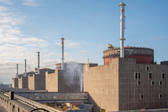Nuclear Facilities as Targets of Military Attack
This project studies the drivers, methods and consequences of military attacks on nuclear facilities in the context of states’ broader military and policy objectives.
Russia’s full-scale invasion of Ukraine produced the first instance of an operational nuclear power plant being subjected to military occupation. Yet, states have targeted nuclear infrastructure in the past, carrying out such attacks for diverse reasons, using a range of methods and with various outcomes.
Nuclear reactors and supporting infrastructure may at once form a key part of a country’s critical national infrastructure, while also posing a potential nuclear weapons proliferation threat and a possible radioactive hazard. As countries move towards more sustainable sources of energy, the role of nuclear power in global energy production is expected to grow. At the same time, more states may seek to pursue nuclear weapons capabilities, potentially disguising their efforts behind seemingly peaceful nuclear programmes.
These factors may increase the likelihood of military attacks on nuclear facilities. This project examines why and how such attacks may be carried out and seeks to assess the implications for the defence of civilian nuclear sites.
Project sponsor
Stanton Foundation
This project is made possible by the support of the Stanton Foundation
Aims and objectives
This project will rely on a review of past cases of military targeting of nuclear facilities to derive conclusions on the following questions.
- Why may militaries target nuclear facilities? What drivers may incentivise a state to conduct a military attack, or undertake a military occupation, of a nuclear site?
- How may militaries target nuclear facilities? What options may be available for conducting a military operation against a nuclear site and what factors inform the methods deployed?
- What are the possible consequences of military attacks on nuclear facilities? What results may an attacking or occupying power achieve in targeting a nuclear site and what are the energy, economic, health and environmental implications?
Russia’s military capture and occupation of Ukraine’s Zaporizhzhia Nuclear Power Plant will act as a primary case study but the research will take a broader historical look at state targeting of nuclear sites.
Based on this research and analysis, the project will identify approaches to strengthening the defence of civilian nuclear sites, disincentivising targeting of these facilities and mitigating the consequences of such attacks. The project will also assess instances in which states may decide to target nuclear sites which pose a proliferation or serious military threat, how such attacks contribute to counterproliferation or military objectives, as well as possible implications of such attacks.




